Pressure manipulation of ultrafast carrier dynamics in monolayer WS2
1 Introduction
Two-dimensional transition metal dichalcogenides (TMDs) have rich electrical, optical, chemical properties, and their bandwidth ranges from visible to infrared. Owing to the excellent mechanical, optical, and electrical properties, TMDs are suitable materials for sensors, catalysts, storage batteries, optoelectronic devices, and excitonic devices[1−4]. Monolayer WS2 is an atomically thin two-dimensional material, which is a sandwich structure, and is composed of a single layer transition metal tungsten (W) and two layers of chalcogen (S)[5, 6].
One key issue in harnessing novel properties of TMDs is to understand and control the carrier dynamic processes. Because the performance of TMDs-based photoelectric devices are closely related to the carrier dynamics process, effective and continuous tuning of carrier dynamics in TMDs is highly desired. Hydrostatic pressure is pure and clean because no additional impurities are introduced by the hydrostatic pressure of the diamond anvil cell (DAC). Recent reports have indicated that the optoelectronic properties of TMDs can be effectively tuned via hydrostatic pressure, such as the interaction of interlayer, material structure, carrier density, and conductivity[7−13]. The semiconductor to metallic phase transition in bulk WS2 is caused by hydrostatic pressure[14, 15]. In contrast, there are few studies on the carrier recombination of monolayer TMDs under pressure. Thus, it is of great value to develop an understanding of the carrier dynamics in TMDs with pressure.
Here, monolayer WS2 is used as a sample to study the carrier dynamics via transient absorption measurements. Our results demonstrate a pressure-induced blue shift of the A-exciton resonance, and two kinds of carrier capture processes of defect states can be continuously tuned by hydrostatic pressure. This study provides basic information for understanding the dynamics of carrier in TMDs, which may be useful in the design of new photoelectric devices that are based on TMDs.
2 Synthesis and material characterization
The WS2 monolayers were grown by CVD technique at 800 °C for 20 min onto SiO2/Si, as shown in
The size of the sample prepared by CVD method can reach 40 μm, as shown in
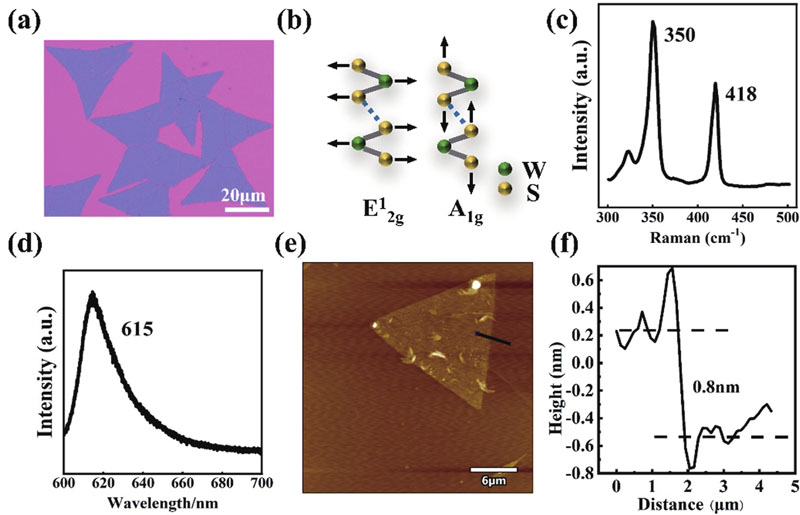
Fig. 2. (Color online) The characterization of monolayer WS2. (a) Optical image of a monolayer WS2. (b) Schematics of Raman modes of E2g1 and A1g. (c) Raman spectra of monolayer WS2 sample. (d) PL spectra of monolayer WS2 sample. (e) AFM image of monolayer WS2 sample. (f) Height image intensity profile along the black line in (e).
The monolayer WS2 was peeled from the substrate with the PVP/PVA adsorption transfer method. The pressure device used in this experiment is a four-column DAC, and the size of diamond plane is 300 μm. The T301 gasket was pre-pressed to 50 μm, and a hole with a diameter of 100 μm was punched in the center with a laser. Silicone oil was chosen as a pressure transmission medium. The silicone oil, the monolayer WS2 sample, and a 10 μm ruby were placed in the hole. The DAC device was used to gradually increase the pressure of the monolayer WS2 heterostructure to 2.91 GPa from 0 GPa, and the direction in which the pressure applied is perpendicular to the plane of the monolayer WS2 sample.
3 Results and discussion
Raman measurements were performed to study the lattice vibration of the monolayer WS2 sample when pressurized in the DAC[17] and the pressure transmission medium (PTM) is silicone oil. The evolutions of Raman spectra show a clear pressure-induced changeover, the feature at 350 cm−1 and 418 cm−1 (E12g and A1g modes of monolayer WS2) blue shift as the pressure increases (as shown in
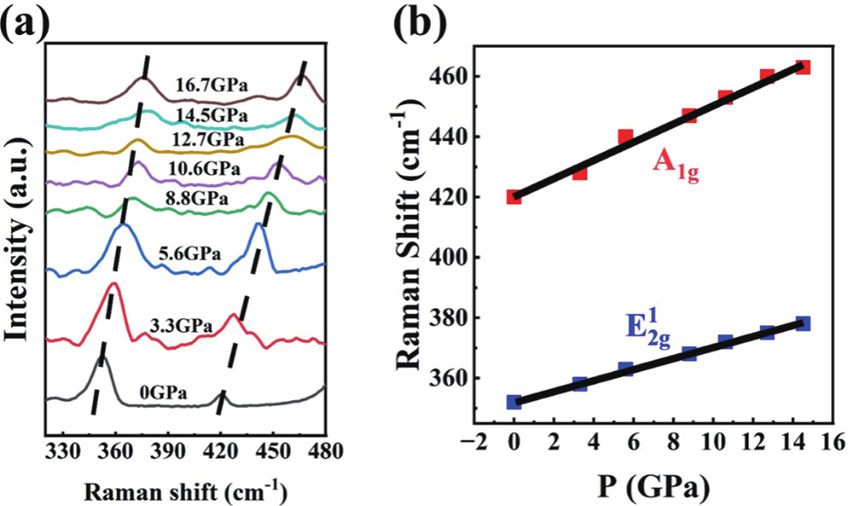
Fig. 3. (Color online) Pressure-induced Raman vibration in monolayer WS2. (a) Evolution of the Raman spectrum with pressure for monolayer WS2 sample. (b) Raman vibrations of monolayer WS2 as a function of pressure.
The PL spectra of monolayer WS2 with different pressures were measured, as shown in
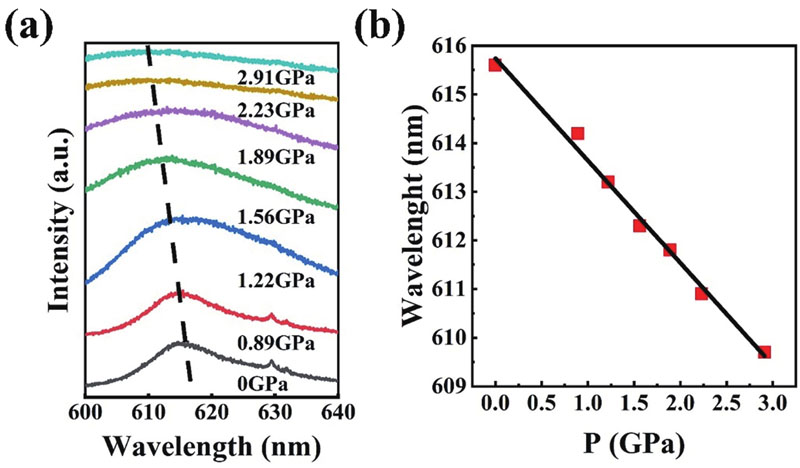
Fig. 4. (Color online) (a) Evolution of the PL spectra of monolayer WS2 sample with pressures. (b) PL peaks of monolayer WS2 as a function of pressure.
The transient absorption (TA) spectra of monolayer WS2 with different pressures were measured to gain more insight of the carrier dynamics process (as shown in
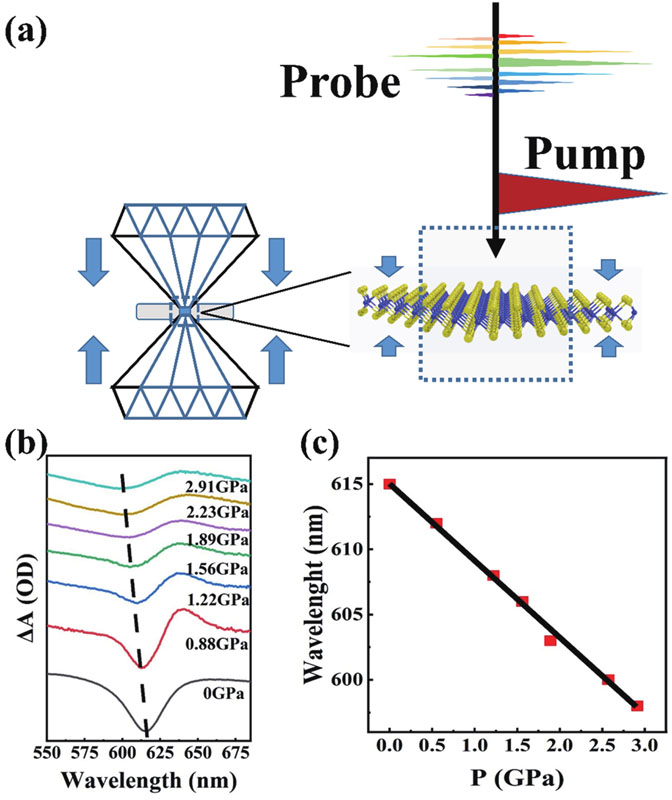
Fig. 5. (Color online) (a) Schematic of material structure and TA measurements of monolayer WS2 in the DAC. (b) Evolution of TA spectra of monolayer WS2 under pressure from 0.30 to 3.25 Gpa. (c) A exciton peaks as a function of pressures.
The absorption peaks of monolayered WS2 lies at 605−615 nm, which can be assigned to the A exciton resonance of WS2, and the photo-induced bleaching signals indicate that the corresponding energy states are occupied by photo-induced carriers. The TA spectra traces of A excitons are shown in
The representative TA signals of A excitons with different pressures were recorded, as shown in
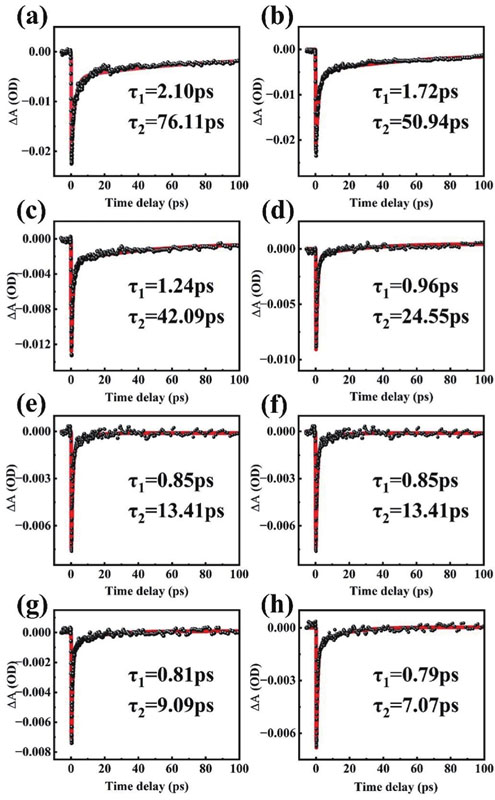
Fig. 6. (Color online) The transient absorption signals of monolayer WS2 with different pressures: (a) 0.55 GPa; (b) 0.89 Gpa; (c) 1.22 Gpa; (d) 1.56 GPa; (e) 1.89 GPa; (f) 2.23 Gpa; (g) 2.56 Gpa; (h) 2.91 GPa. The red lines are fitting.
It should be noted that the carrier capture process gets faster when increasing the pressure from 0.55 to 2.91 GPa, and can be divided into two distinct regions according to the slope variation of time constants upon compression, as shown in
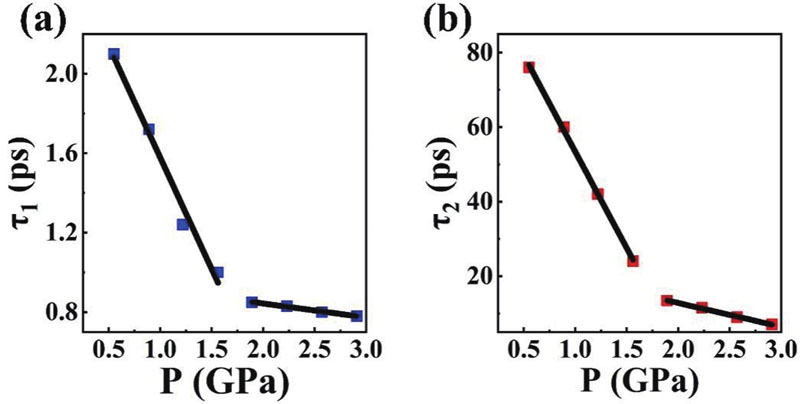
Fig. 7. (Color online) The time constants (a) τ1 and (b) τ2 of A exciton as a function of pressure.
For monolayer TMDs, the time constants τ1 and τ2 can be assigned to the carrier trapping process of the shallow and deep defect state with different capture rates. Considering the reduced dielectric screening effect and strong quantum confinement effect of TMDs, the Auger type dynamic process can be realized at low carrier densities. The τ1 and τ2 may be caused by Auger type carrier capture process of defect states, which means the electrons or holes in exciton states are captured by defect states by transferring the excess energy to other electrons and holes to satisfy the energy conservation law[29, 30]. According to this model, the quantum confinement effect may be enhanced by increasing the pressure, and the carriers are much easier to collide with other carriers. This feature means that the carriers are easier to release the excess energy to other electrons or holes, and this is beneficial for the Auger type carrier trapping process[31−33]. However, there is a different model that can explain the pressure-induced acceleration of the carrier capture process—the pressure can shorten the W−S bond in the monolayer WS2, and enhance the vibration between W and S atoms, which can increase phonon energy and be confirmed by the above Raman results. This feature is conducive to meet the requirements of energy and momentum conservation in the capturing process[20, 21].
At around 1.56−1.89 GPa, a turning point appears and changes the time constants of two decay process with the decrease of pressure, which may result from the pressure induced changeover of the electronic structure. Both of the transient components are fully recovered when the pressure is released. Thus, the results clearly demonstrate that the band structure and carrier dynamics processes of monolayer WS2 can be accurately manipulated by hydrostatic pressure.
4 Conclusions
In summary, we have synthesized a sample monolayer WS2 to study the optical response of the sample with pressure via Raman spectroscopy and transient absorption spectroscopy. We found that hydrostatic pressure can be an efficient method to tune the lattice vibrations. The transition spectra were analyzed by tracking the energy shift and carrier dynamics of A exciton with different pressures. The results demonstrate the efficient tuning of band structure and photo-induced carrier recombination processes by pressure engineering. Our findings provide the basic information for understanding carrier dynamics in atomically thin TMDs under external strain.
Article Outline
Yao Li, Haiou Zhu, Zongpeng Song. Pressure manipulation of ultrafast carrier dynamics in monolayer WS2[J]. Journal of Semiconductors, 2023, 44(8): 082001.




